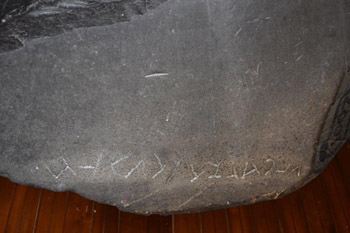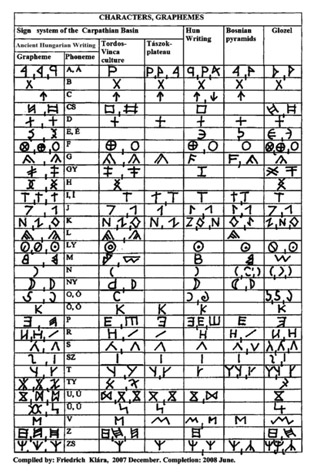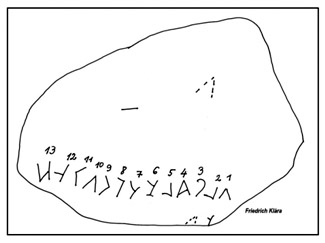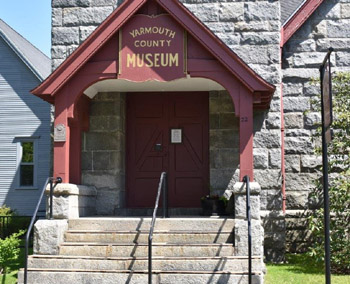|
|
|
The Yarmouth Runic Stone
|
|
|
The Yarmouth Runic Stone |
Written
by Klara Friedrich, Budapest
Translated by: Ernő Kovács, Calgary

Photo by Charles Sucsan, 2018.
Susan Tomory, a researcher of Hungarian language wrote in the Hungarian Scientific Bulletin, No. 3, (1998) about the runic stone found in Yarmouth, Nova Scotia. I read it for the first time. Tomory contacted the Yarmouth Museum and Historical Library with her questions. She received a reply on 14 December 1996. A brief synopsis of this communique follows:
Dr. Richard Fletcher, a retired military surgeon, discovered the stone in 1812. According to some historians, he counterfeited the stone, which had a weight of 400 pounds or 200 kilograms. The top of the stone is flat, on which are 13 well-preserved letters and 3 faint ones. There are many and varying opinions about the source of these letters: Viking, Basque, ancient Japanese, early Greek. There was a researcher who postulated that each letter came from a different cultural group.
The Hungarian origin of the stone was first put forth by Frank Kovatch in an article published in the Yarmouth Herald on 21 January 1936, in which he hypothesized the result of his research -- the kinship of the Scythian, Uighurs and the North American Natives. His decoding technique is not apparent from the writing on the stone.
The following excerpt may be found in the article published in the Hungarian Scientific Bulletin: "The writing on the Yarmouth stone may be understood with the help of Transylvanian runic writing, which are read from right to left. Academic research has proven that Lief Ericson and his vikings arrived in America one thousand years ago, in 992. Their Chronicles mention a stranger named Tyrkir (Turk) who may have written the Yarmouth runic stone".
In the August 1996 edition of the newspaper titled 'Magyarsag' (Hungarian), Maria Rabl (nee Szilvan) announced her decipherment: "(Erik)son walked in this place along with many of his fellows".
In April 2013, I received a letter from Dr. Kinga Madarasz (Kinga La Chapelle, after her husband) who lives in Albany, New York. According to her, the writing was originally engraved onto a steel plow; and Dr. Fletcher copied it to the stone. Referencing the Bible along with using the sound values of Hungarian runic writing: SaLaMON harvested with the plow. This incites the plow to eloquent words. (Original Hungarian: SaLaMON aRaTaTSZ SZaNTOT. IJJ eKes SZoDRa uSZiT) (the lower-case letters reference the missing vowels).
Zsuzsa Tomory wrote that in 1966 another runic stone was found in Yarmouth. This find rules out that Dr. Fletcher's discovery of 1812 was a forgery.
In 2009, I wrote my first report of this stone which included good quality photographs I received from Arpad Rethy. My opinion is that the stone clearly contains ancient Hungarian runic writing. In order to substantiate my claim, I collected some symbols found on runic relics that parallel those on the stone: the discovery made at Tordos by Zsofia Torma from the new stone age in the Tisza civilisation; on the rocks of the Taszok-teto (in Transylvania); the Hun writing on a Swiss beam as per Tibor Barath's book; on an Avar needle case in Szarvas; on a calendar cane in the Arpad epoch; on the Bögöz and Rugonfalva church wall; amongst the markings on the Magyarvalko church; the Gyulafehervar Reformed Church's dorm's alphabet, and so forth...
There are parallels outside of the Carpathian Basin in the French Gozel settlement and on the rocks in the tunnels of the Bosnian Sun Pyramids (Please refer to my attached table where such symbols may be identified).

The sound values of the symbols are my propositions, with the ancient Hungarian runic letters, which are read from right to left, according to the number of the drawing.

1: S
2: N The square letters were mostly used on harder surfaces, for example,
stone, metal, wood.
3: O-N runic grouping (ligature)
4: T-A grouping (ligature) or S-A-S grouping
5; N
6: T - the lower line may be a grouping of I-T (ligature)
7: T
8: I or J
9: N
10: S
11: This is also the letter N, the writer, for decorative purposes, inverted
the letter so that the letter S would fit nicely in between the two N
letters. (The attribute of beauty was greatly valued and was also used in Egyptian
hieroglyphs).
12: The next letter R has an R grouping (ligature).
13: R
My analysis consists of the following letters: S, N, ON, TA, N, IT, T, J, N, S, N, R, R,
''SN'' - ON TA N IToTt JeNSeN eRRe
So: Jensen taught at "Sn" around here.
The "Sn" refers to the location where the teaching took place, but because of the passing of time, it cannot be now identified. Explanation: In a place called SN (San, Sun, Son, Sone, etc.), a man called Jensen taught a student how to write runic onto the stone. The SN (Sun? Son?) could have been a settlement or possibly the name of a ship. Though, the name Jensen was common in German and Danish; he could have been an interpreter or an ambassador who knew the language of Avars-Magyars. Hence, he could have disseminated the language writing in this manner.
There are two uncertain signs on the stone. In the middle, an S and a T at the bottom.
I agree with those who connect the stone with the Vikings. In this way, I date the writing to be between the 8-10 century AD.
Clearly the letters are from the Hungarian runic: 1. (and 10.) 3. 4. 6. (and 7.) 13. Five letters, and two letters repeat. There are four runic groupings (ligature): 3. 4. 6. 12-13.
Similar to Greek letters: 1. (and 10.) 4. 6. (and 7.) 8. Four letters, two of them repeat.
Similar to Latin letters: 9. (and 11.) 12. (turned towards the right). Two letters, one of them repeats.
Similar to German Runes: 9. (and 11.) 12. Two words, one repeats.
However, because of the ligatures, it is clear that this is a manner of Hungarian writing or their predecessors (Scythians, Huns, Avars), as this inventive abbreviation is almost exclusively reflective of their writing style.
I wrote my study in 2009, and in 2011 and 2013 I supplemented it with a parallel of symbols. Charles Sucsan, a Hungarian painter (artist), visited the museum in 2018 and sent me new photographs of the stone, thanks for these.
Budapest, Hungary, 2018.

Photo by Charles Sucsan, 2018.
|
|
|
The Yarmouth Runic Stone
|
|
|